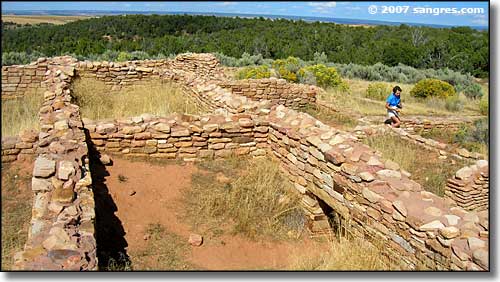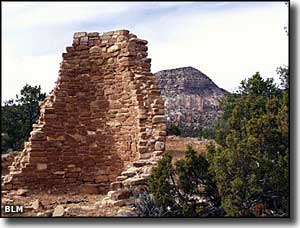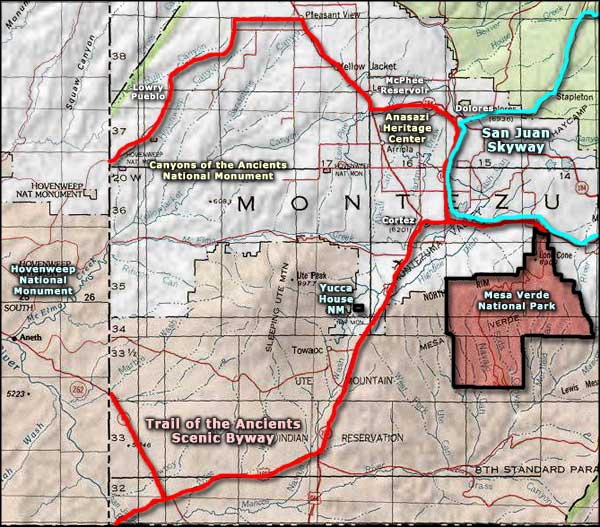
Canyons of the Ancients National Monument

A section of the ruins at Lowry Pueblo

Canyons of the Ancients National Monument contains the Colorado sections of Hovenweep National Monument. The area has been inhabited for at least 10,000 years but most of the evidence seen these days has been in place since about 1500 BCE when the Basketmaker culture first appeared. The Basketmakers were primarily hunter-gatherers but they also seem to have been the first corn farmers. They also left some beautiful basketry samples and artifacts indicating there were already far-ranging trade routes in place when they occupied the countryside.
By 750 CE their constructions had evolved beyond the pithouse stage and many masonry-built, square-roomed structures were in place. Pueblos of many rooms were coming into their own and samples of their highly stylized pottery is still found all across the countryside. The usual story is that the weather patterns changed and the area got so arid that many of the folks migrated south and east, to the areas of Zuni and the Rio Grande Pueblos around 1300 CE. That was also about the same time representatives of the Aztec death cults seem to have appeared in the area, bringing the nastier aspects of their "religion" with them. As the Ancestral Puebloans left, in came the Ute and Navajo nomads who were still fighting over the area when the Spanish arrived in the 1500's. The 1800's saw an influx of Euroamerican settlers who established farms and ranches in the area but even today, access to the region is hard because there are only a few, mostly unpaved roads. One thing to watch out for when traipsing around Canyons of the Ancients National Monument: the BLM holdings that make up the National Monument are scattered among many private properties.
Very little in the way of excavation has occurred on the property but most of the ancient artifacts that have been found are stored or on display at the Anasazi Heritage Center. The best way to begin a visit to Canyons of the Ancients National Monument is to stop at the Heritage Center and get your bearings.
Certain pueblos have been excavated and others have been stabilized (so they don't collapse further into rubble piles). There is signage pointing to most of them but all are off the beaten path. Many are accessible only on foot. Many folks try to include a visit to Lowry Pueblo in their trip through the area as Lowry is one of the easiest sites to access. If you have more time, you might search out and visit Painted Hand Pueblo, too. But almost everywhere you go at Canyons of the Anceints National Monument, you're liable to stumble across ancient ruins. The thing is: you might not know it because so much of the ancient inventory is in one stage of collapse or another. In some places there are parts of standing towers, in others there is only a scatter of rocks out of place to indicate that something was built here so many hundred years ago.
Very little of Canyons of the Ancients National Monument is universally accessible. In most areas, the parking area and marked trail are the only amenities. Many sites still retain spiritual signifance among today's Native American tribes in the region. Take only photos, leave only footprints. When you come across petroglyphs, pictographs and painted or plastered walls, remember that the skin oil left by your touch will eventually destroy them. Do your picnicking away from archaeological sites as any crumbs you drop will attract rodents who will tunnel and nest in the site, also contributing to its eventual destruction. Stay away from archaeologiacl sites in low light conditions so that you don't accidently disturb anything in the darkness and add to the destruction.

Anasazi Heritage Center - Yucca House National Monument
Hovenweep National Monument
National Park Service Sites - BLM Sites - National Wilderness Areas - Unique Natural Features
Outdoor Sports & Recreation - Ski & Snowboard Areas - Photo Galleries - Colorado Mountains
